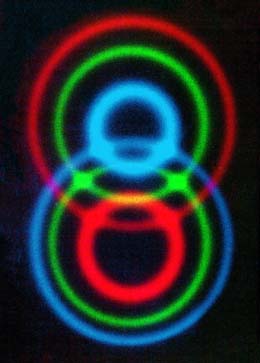
The tenuous light from a nonlinear crystal was recorded on high speed infrared film. In the parametric down-conversion process one out of 106 ultraviolet photons converts into two photons. These pairs of spontaneous down-conversion photons exhibit interesting quantum properties.

This is the first photograph ever taken with photons of type-II down-conversion. Three exposures were made using 5nm bandwidth interference filters with center wavelengths of 681nm, 702nm, and 725nm. The film was 11cm from the crystal with the ultraviolet laser beam (300mW, wavelength 351nm) pointing to the center of the film. The exposure time was one hour for each layer. A stack of filters was used to cut out all ultraviolet light. The three B/W infrared layers are color coded in this picture: Blue (681nm), Green (702nm), Red (725nm).
Entangled photon pairs from this source were used to demonstrate a violation of the Bell inequality by over 100 standard deviations. This source is presently used in the Innsbruck Quantum Optics Laboratory for experiments in quantum information coding.
Photograph © 1995 by Michael Reck and Paul G. Kwiat
The down-conversion photon pairs are emitted in directions determined by the phase-matching conditions and energy conservation in the Beta Barium Borate (BBO) crystal. In type-II down-conversion the polarization of one cone is parallel while the other is perpendicular to the pump beam. Our photograph shows the projection of the cones on the infrared film for the pairs (681 & 725 nm), (702 & 702 nm), and (725 & 681 nm). Along the intersections of the cones of the same wavelength (in our photograph the green circles) polarization-entangled photon states can be observed.
